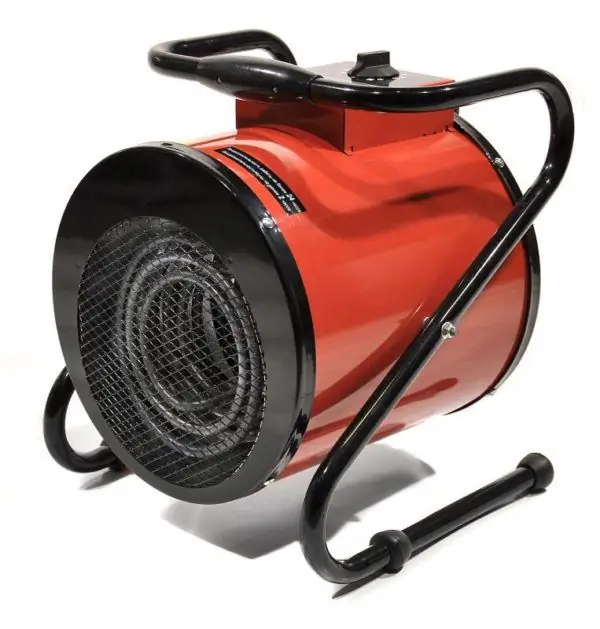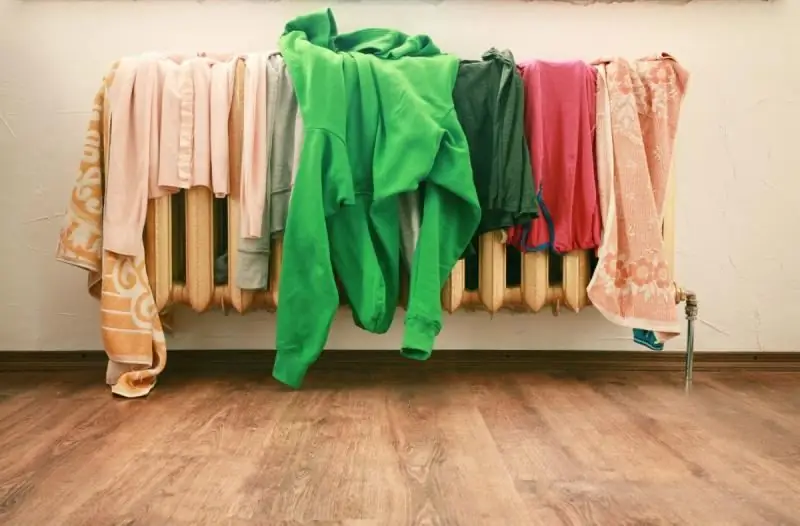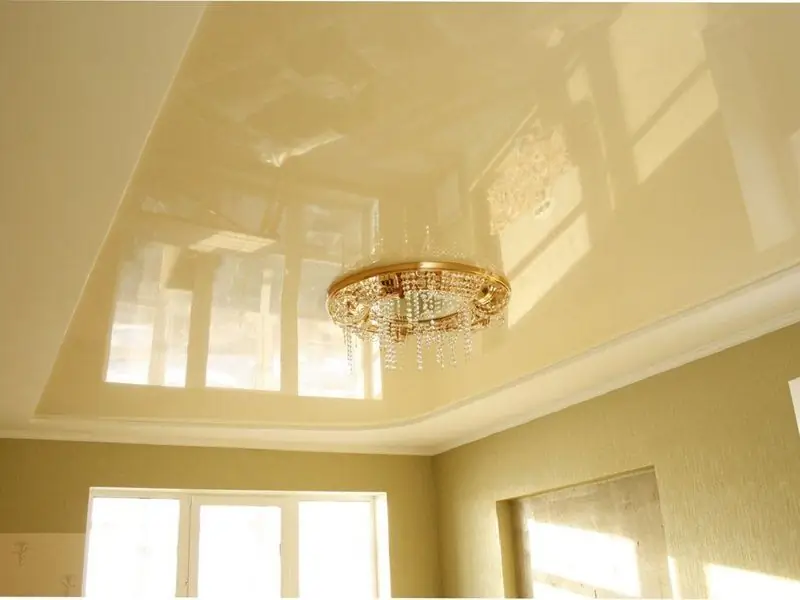
Table of contents:
- Author Bailey Albertson [email protected].
- Public 2023-12-17 12:53.
- Last modified 2025-01-23 12:41.
How to drain water from a stretch ceiling

Most of the residents of apartment buildings are aware of the possibility of flooding an apartment from the upper floors. Therefore, water on a stretch ceiling is, although infrequent, but quite likely. Knowing how to fix this problem and its consequences will help you cope with the task quickly and efficiently.
Content
-
1 How much water can a stretch ceiling withstand
-
1.1 Properties of a stretch ceiling made of polyvinyl chloride film
1.1.1 Video: what happens to a PVC stretch ceiling during a flood
-
1.2 Properties of a stretch ceiling made of fabric
1.2.1 Video: what happens to a fabric suspended ceiling when flooded with water
- 1.3 How many days will a stretch ceiling filled with water withstand
-
-
2 How to remove water from a stretch ceiling
- 2.1 Priority actions
-
2.2 How to drain the water yourself
2.2.1 Video: how to drain water from a stretch ceiling
- 2.3 How to dry the canvas after draining the water
- 3 How to prevent water from entering a stretch ceiling
How much water can a stretch ceiling withstand
Manufacturers claim: stretch ceilings are a barrier to water and guaranteed protection of the interior of an apartment from flooding, provided that the volume of water per square meter of coverage does not exceed 100 liters. It is necessary to take into account a number of factors:
- the larger the stretch ceiling area, the lower the permissible load on the canvas;
- the higher the degree of tension of the material, the lower its density and strength;
- the properties of the material from which the stretch ceiling is made are of great importance.
The real amount of water that a stretch ceiling can withstand per square meter is from 70 to 120 liters.
The material from which stretch ceilings are made can be of two types: fabric cloth or polyvinyl chloride film.
Properties of a stretch ceiling made of polyvinyl chloride film
Polyvinyl chloride film, or PVC film for short, has high elasticity and strength. On contact with water, it does not change color, does not absorb or let moisture through. When flooded, water does not spread over the ceiling surface. The film coating stretches and sags in the place where the water originally entered, forming a so-called bubble.

The ceiling made of PVC film stretches and sags in the place where the water originally entered
Do not pierce the bubble to drain the water. A small hole under the weight of the water will very quickly turn into a large film tear. It will be impossible to restore the coverage.
Video: what happens to a PVC stretch ceiling during a flood
Fabric stretch ceiling properties
Stretch fabric ceilings do not tolerate interaction with water. Waterproof qualities are provided by a special varnish coating. But with a poor-quality varnish coating, the stretch ceiling lets water in places. The fabric base of the ceiling has low elasticity; during flooding with water it stretches slightly and practically does not sag. With a large amount of water, it breaks out of the mountings and cannot be restored.

With a large amount of water, the fabric fabric breaks out of the fasteners and cannot be restored
Video: what happens to a fabric suspended ceiling when flooding with water
How many days will a stretch ceiling filled with water withstand
If the amount of water on the ceiling does not increase, then the stretch ceiling can hold it indefinitely. You should not delay solving the problem for a long time. Increased humidity in a closed space above the ceiling contributes to the formation of mold. In addition, the film, which is strongly stretched under the weight of water, can burst when it comes into contact with the edges of the lamp, the corners of furniture, or any sharp object. There is a risk of rupture if water accumulates at the junction of the stretch ceiling coverings. It is advisable to drain within 2-3 days, following the rule: the sooner you start solving the problem, the sooner it will disappear.

Film stretched heavily under the weight of water may burst if it touches sharp edges of surrounding objects
How to remove water from a stretch ceiling
Most of the firms involved in the installation of stretch ceilings also provide their service, have the necessary tools and skills to resolve such issues. Therefore, professionals can be involved to eliminate water.
Priority measures
Immediately after detecting water on the stretch ceiling, do the following:
-
Disconnect electricity. This will exclude the possibility of a short circuit in the mains and electric shock on contact with water.

Power outage Disconnection of electricity will eliminate the possibility of a short circuit in the mains and electric shock when in contact with water
-
Notify neighbors of an existing problem or shut off the water supply to the riser. This must be done so that the amount of water on the ceiling does not increase. The water riser valve is usually located in the basement.

Pipes Shut off the water supply so that its amount on the stretch ceiling does not increase
-
If you are not sure of your own strength, contact the manager of a company that provides services for the maintenance of stretch ceilings. Describe the problem you encountered and agree on the date and time of the specialists' visit.

Telephone in the hands of a man If you are not sure of your own strength, contact the manager of the company providing services for the maintenance of stretch ceilings
-
Remove items from the room that can be damaged by water: equipment, carpets and other items.

Take the TV out of the room Remove equipment and other valuables from the room that may be damaged by water
-
Cover large furniture with plastic wrap.

Upholstered furniture in the interior Upholstered furniture should be covered with plastic wrap
-
Prepare containers for collecting water: buckets, basins, pots. There should be a lot of them.

Buckets To collect water, you will need a lot of containers - buckets, basins, pots
How to drain water yourself
- Find at least one assistant for the job, and preferably two. You cannot remove water alone.
-
Select a place on the ceiling through which you will drain. The most convenient way to do this is through the holes for the lighting fixtures. If they are not there or they are far from the accumulation of water, you can select the closest point for attaching the suspended ceiling to the wall for draining.

Ceiling light hole The most convenient way to remove water from the ceiling is through a hole for a lamp or chandelier.
- Place a ladder or sturdy table under the drain.
- Remove the lamp or chandelier. By the time this procedure is started, the electrical appliance should already be de-energized.
-
Remove the decorative tape, carefully detach the stretch ceiling harpoon from the aluminum profile using a special spatula with rounded ends.

Putty knife Spatulas with a rounded working part are convenient to use when working with stretch ceilings
-
Hold the edge of the blade firmly to keep it from pulling out of your hands. Otherwise, water will flood the room.

Preparing to drain water from the ceiling To drain the water, you can select the closest location for attaching the suspended ceiling to the wall
-
Use a rubber hose. Insert one end of it into the hole in the ceiling and bring it to the place where the water accumulates. Lower the other end into a collection container.

Insert a rubber hose into a hole in a stretch ceiling Use a rubber hose to drain the water.
-
The assistant should slightly raise and support the sagging ceiling. At the same time, water will rush through the hose into the collection container.

A man holds a sagging stretch ceiling When draining the water, an assistant is needed to slightly raise and hold the sagging ceiling
- When the container is filled with water, squeeze the end of the hose with your fingers and lower it into another container. The second assistant can empty the containers and be on the hook.
-
If the light hole is at the bottom of the water bubble, the hose does not need to be used. The water will pour into the bucket by gravity.

Drain water from the ceiling without a rubber hose If the hole for the lamp is at the bottom of the bubble, the water is drained by gravity into the bucket without using a hose.
- Proceed in this way: when the water flow decreases, lift the sagging part of the ceiling sheet a little more and drain the water in the container. Well-coordinated work of a team of two or three people will very quickly lead to the desired result.
- After all the water has been removed from the ceiling, tuck the canvas harpoon into the baguette profile if using an edge drain. Reinstall the lamp or chandelier after the canvas is completely dry.
Video: how to drain water from a stretch ceiling
Without special skill, it is not recommended to smooth out a sagging stretch ceiling, trying to move water to the drain hole. Water can spill over a larger surface, making it more difficult to collect. The best solution would be to use a flexible drainage hose.
How to dry the canvas after draining the water
After the water has been drained at the place of its concentration, the tension web has a sagging, highly deformed surface. It can be returned to its previous shape by heat treatment. Companies specializing in this use heat guns for high-quality drying. The process takes very little time and there is no trace of the former ceiling deformations.

Professional device used for drying stretch ceilings
This problem can be solved independently, using a construction or ordinary hair dryer, turning it on at the maximum temperature and holding it at a distance of 20-30 cm from the ceiling surface. The work is quite time consuming and will take a long time, but it will allow you to achieve a good result.

To dry the stretch ceiling, you can use a construction hair dryer
How to prevent water from entering a stretch ceiling
You can avoid flooding the apartment or getting water on the stretch ceiling by waterproofing the floor in the apartment from above: by laying a bituminous and roofing material screed. In this case, all the water spilled in the apartment from above will remain within this apartment. The method requires serious construction work: you will have to remove the floor covering, lay waterproofing materials and re-lay linoleum or lay tiles. It will not protect against flooding when pipes flow in the ceiling between floors. It is inappropriate to start all this for the sake of prevention. If the neighbors from above are starting repairs, then it makes sense to talk to them about waterproofing the floor.

If the neighbors upstairs are making repairs, offer them to waterproof the floor.
As you can see, it is not difficult to remove water from a stretch ceiling and completely restore its appearance. But if you don't want to do this on your own, you can turn to professionals for help, and present the bill for their services to your neighbors from above.
Recommended:
How To Hang A Chandelier On A Stretch Ceiling + Video

Features of fixing a chandelier to a stretch ceiling. Choosing a chandelier design, a step-by-step description of the installation process
A Step-by-step Guide To Erecting A Floor In A Bathhouse (including With A Drain) With Your Own Hands With Photos, Videos And Drawings

Do-it-yourself flooring requirements and technologies in various rooms of the bath. Step by step guide. Photo and video
Why You Can't Dry Your Clothes In Your Apartment

On the problems that arise when drying clothes in an apartment
How And What To Wash A Stretch Glossy Ceiling Without Streaks, How To Care + Video

How to properly wash stretch ceilings, what means it is fashionable to use for this. Maintenance rules for such ceilings
How To Install A Stretch Ceiling Yourself: Detailed Recommendations And Advice, Video

Types of stretch ceilings. Practical tips for installing stretch ceilings, tools and materials
